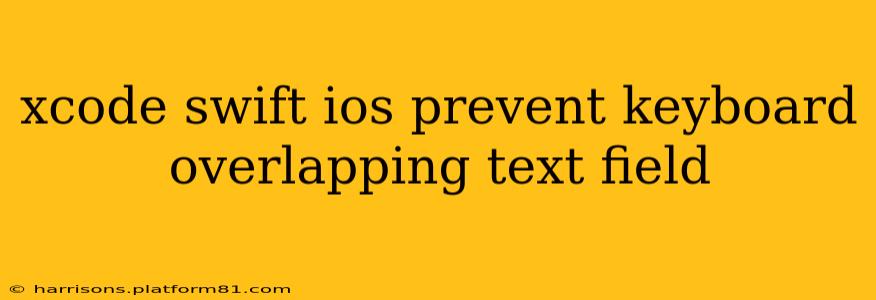Developing iOS apps often involves handling user input, and a common challenge arises when the keyboard obscures text fields. This frustrating user experience can be easily mitigated using Swift and Xcode's built-in features. This guide will show you how to prevent your keyboard from overlapping text fields in your iOS app, ensuring a smooth and user-friendly experience.
Understanding the Problem: Keyboard Overlap
When a user interacts with a text field in your iOS app, the onscreen keyboard appears. If the text field is positioned near the bottom of the screen, the keyboard can completely or partially cover it, making it impossible for the user to see what they're typing or even interact with the field. This is a major usability issue.
The Solution: Adjusting the View's Frame
The most effective solution is to adjust the view's frame dynamically when the keyboard appears and disappears. This involves using NSNotificationCenter to observe keyboard notifications. We'll use UIResponder's becomeFirstResponder method to trigger the keyboard appearance and resignFirstResponder to handle its dismissal.
Here's how to implement this in your Swift code:
import UIKit
class ViewController: UIViewController {
@IBOutlet weak var myTextField: UITextField!
override func viewDidLoad() {
super.viewDidLoad()
// Observe keyboard notifications
NotificationCenter.default.addObserver(self, selector: #selector(keyboardWillShow), name: UIResponder.keyboardWillShowNotification, object: nil)
NotificationCenter.default.addObserver(self, selector: #selector(keyboardWillHide), name: UIResponder.keyboardWillHideNotification, object: nil)
myTextField.delegate = self
}
deinit {
NotificationCenter.default.removeObserver(self)
}
@objc func keyboardWillShow(notification: NSNotification) {
if let keyboardFrame: NSValue = notification.userInfo?[UIResponder.keyboardFrameEndUserInfoKey] as? NSValue {
let keyboardRectangle = keyboardFrame.cgRectValue
let keyboardHeight = keyboardRectangle.height
// Adjust the view's frame to avoid overlap
UIView.animate(withDuration: 0.3) {
self.view.frame.origin.y -= keyboardHeight
}
}
}
@objc func keyboardWillHide(notification: NSNotification) {
UIView.animate(withDuration: 0.3) {
self.view.frame.origin.y = 0
}
}
}
extension ViewController: UITextFieldDelegate {
func textFieldShouldReturn(_ textField: UITextField) -> Bool {
textField.resignFirstResponder()
return true
}
}
This code adds observers for keyboard show and hide notifications. When the keyboard appears, it calculates the keyboard height and adjusts the view's origin.y to move the entire view upward, preventing the overlap. When the keyboard disappears, the view returns to its original position. The textFieldShouldReturn delegate method ensures that pressing return on the keyboard dismisses the keyboard.
Using UIScrollView for Scrollable Content
For complex layouts with multiple text fields, a UIScrollView provides a more robust solution. This allows users to scroll the content if the keyboard still obscures fields even after adjusting the main view's frame. This approach is particularly beneficial for forms with many input fields. You would still use keyboard notification observers but adjust the contentOffset of the scroll view to move the active text field into view.
Adjusting contentInset of UIScrollView
Instead of adjusting the view.frame.origin.y directly, you can also modify the contentInset of your UIScrollView to account for the keyboard's height. This approach keeps the view's frame intact but shifts the visible content within the scroll view.
Third-Party Libraries
While the above methods provide effective solutions, several third-party libraries simplify keyboard management. Research libraries that provide features like automatic keyboard avoidance and adaptive layout adjustments. These can streamline the implementation process, especially for more intricate scenarios.
Testing Thoroughly on Different Devices and iOS Versions
Remember to thoroughly test your implementation on various iOS devices and versions. Keyboard heights can vary, and edge cases might need additional adjustments.
This comprehensive guide provides multiple approaches to handling keyboard overlap. By choosing the appropriate method and implementing it carefully, you can ensure your iOS app offers a consistently smooth and enjoyable user experience. Remember to always test your solution thoroughly.
